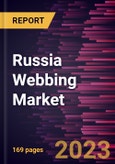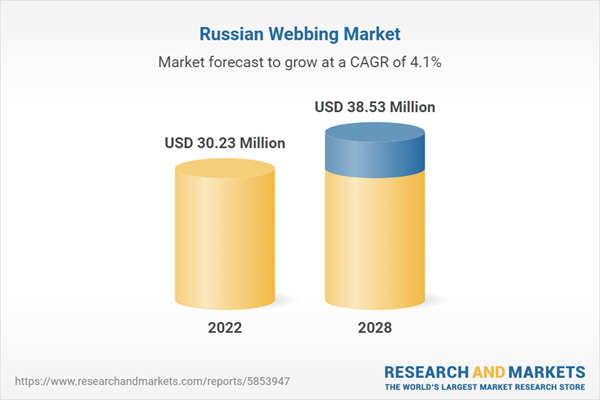The Russia webbing market is expected to grow from US$ 30.23 million in 2022 to US$ 38.53 million by 2028. It is expected to grow at a CAGR of 4.1% from 2022 to 2028.
Webbings are available in natural and synthetic or man-made forms. Cotton webbing is a natural textile, offering a natural alternative to nylon and polyester webbing. It is an all-purpose and lightweight webbing material made from a renewable resource. It is also available in a variety of weights and colors. It is used in making numerous products, including luggage, belts, medical products, apparel trim, handbags, military products, sporting goods, and pet products. Cotton webbing has various advantages over other types of webbing materials, including its ability to eliminate static electricity. Although thin and lightweight, cotton webbing can be very robust. This material is the easiest to sew and has the best texture. Hemp webbing is another versatile, eco-friendly, and durable alternative to traditional synthetic materials.
Based on end use, the Russia webbing market is segmented into aerospace, automotive, military, industrial and safety, fashion accessories, e-textile, sport goods, marine, medical, and others. In 2022, aerospace segment held a significant market share, and is expected to be the fastest growing segment during the forecast period. Development and use of webbing have revolutionized the aerospace industry. Woven webbing is used in the industry because it is lightweight and provides high performance to meet rigorous industry standards. Woven webbing has various applications in the aerospace industry because of its easy-to-clean features and ability to resist heat, chemicals, and abrasion. Further, the specialized narrow fabrics, 2D and 3D thermosets, thermoplastic fabrics, and novel E-WEBBINGS narrow woven fabrics are suited for meeting specific strength requirements of structural components in the industry. Additionally, these materials are widely used in crucial aerospace industry applications such as parachutes, cargo restraint systems, and seating, as well as in interior applications, including crew safety system components, flight suits, air slides, seatbelts, and flotation devices.
Russia webbing market growth is attributed to the growing automotive industry in the country, producing passenger vehicles, and light and heavy commercial vehicles. In the automotive industry, webbing is highly used in applications such as seat belts, safety harnesses, towing straps, binding for luggage nets, and pull straps. Webbing is also used in door handles or boot/hatchback handles. In the automotive industry, nylon, polypropylene, and polyester webbings are commonly used in applications such as airbag tethers, battery straps, boot lining assemblies, and car mat bindings. Hence, the government's focus on ramping up automotive production in Russia bolsters the webbing market growth in the country. Further, aircraft manufacturing is a prominent industry in Russia. The country is involved in producing civilian and military aircraft, and helicopters. It is one of the largest arms exporters in the world. The Russian government is focusing on shoring up its domestic manufacturing, adopting an import substitution policy, and incorporating more Russian-built components into aircraft of domestic make, subsequently reducing dependence on foreign suppliers. Therefore, aforementioned factors are expected to positively contribute to the growth of webbing market in Russia.
The COVID-19 pandemic affected economies and industries in various countries across all the continents with lockdowns, travel restrictions, and business shutdowns. These shutdowns disturbed Russia supply chains, manufacturing activities, delivery schedules, and product sales. Various companies announced possible delays in product deliveries and a slump in future sales of their products in 2020. In 2020, various industries had to slow down their operations due to disruptions in the value chain caused by the restrictions on national and international boundaries. Disruptions in the supply chain and shutdowns of production facilities negatively impacted the webbing market growth in 2020. Due to the COVID-19 pandemic, the demand for webbing demand slowed down due to an expected drop in the production of aircraft, military equipment, automotive, and sporting goods.
In 2021, the Russia webbing market witnessed a positive recovery as governments of various countries announced the relaxation of previously imposed restrictions. The manufacturers were permitted to work at full capacity, thus leveraging their profitability. However, the marketplace began recovering from the losses incurred as the country's government announced relaxation in social restrictions. Moreover, the rising vaccination rates and reopening of industrial activities led to conducive environments for industrial progress. Increasing production of aircraft, military equipment, automotive, and sporting goods in Russia has mainly driven the demand for webbing.
Ningbo MH Industry Co Ltd, Bowmer Bond Narrow Fabrics Ltd, Stretchline Ltd, Helmut Pfeiffer GmbH & Co KG, ETS LECUYER SaRL, Fantex Industrie SAS, Eurosandow SAS, PMS Industrie SAS, and EP Launcher International Co Ltd, are among the leading players in the Russia webbing market. These companies are adopting strategies such as mergers & acquisitions and product launches to expand their geographic presence and consumer bases.
The overall Russia webbing market size has been derived using both primary and secondary sources. To begin the research process, exhaustive secondary research has been conducted using internal and external sources to obtain qualitative and quantitative information related to the market. Also, multiple primary interviews have been conducted with industry participants to validate the data and gain more analytical insights. Participants of this process include industry experts such as VPs, business development managers, market intelligence managers, and national sales managers - along with external consultants, including valuation experts, research analysts, and key opinion leaders - specializing in the Russia webbing market.
Webbings are available in natural and synthetic or man-made forms. Cotton webbing is a natural textile, offering a natural alternative to nylon and polyester webbing. It is an all-purpose and lightweight webbing material made from a renewable resource. It is also available in a variety of weights and colors. It is used in making numerous products, including luggage, belts, medical products, apparel trim, handbags, military products, sporting goods, and pet products. Cotton webbing has various advantages over other types of webbing materials, including its ability to eliminate static electricity. Although thin and lightweight, cotton webbing can be very robust. This material is the easiest to sew and has the best texture. Hemp webbing is another versatile, eco-friendly, and durable alternative to traditional synthetic materials.
Based on end use, the Russia webbing market is segmented into aerospace, automotive, military, industrial and safety, fashion accessories, e-textile, sport goods, marine, medical, and others. In 2022, aerospace segment held a significant market share, and is expected to be the fastest growing segment during the forecast period. Development and use of webbing have revolutionized the aerospace industry. Woven webbing is used in the industry because it is lightweight and provides high performance to meet rigorous industry standards. Woven webbing has various applications in the aerospace industry because of its easy-to-clean features and ability to resist heat, chemicals, and abrasion. Further, the specialized narrow fabrics, 2D and 3D thermosets, thermoplastic fabrics, and novel E-WEBBINGS narrow woven fabrics are suited for meeting specific strength requirements of structural components in the industry. Additionally, these materials are widely used in crucial aerospace industry applications such as parachutes, cargo restraint systems, and seating, as well as in interior applications, including crew safety system components, flight suits, air slides, seatbelts, and flotation devices.
Russia webbing market growth is attributed to the growing automotive industry in the country, producing passenger vehicles, and light and heavy commercial vehicles. In the automotive industry, webbing is highly used in applications such as seat belts, safety harnesses, towing straps, binding for luggage nets, and pull straps. Webbing is also used in door handles or boot/hatchback handles. In the automotive industry, nylon, polypropylene, and polyester webbings are commonly used in applications such as airbag tethers, battery straps, boot lining assemblies, and car mat bindings. Hence, the government's focus on ramping up automotive production in Russia bolsters the webbing market growth in the country. Further, aircraft manufacturing is a prominent industry in Russia. The country is involved in producing civilian and military aircraft, and helicopters. It is one of the largest arms exporters in the world. The Russian government is focusing on shoring up its domestic manufacturing, adopting an import substitution policy, and incorporating more Russian-built components into aircraft of domestic make, subsequently reducing dependence on foreign suppliers. Therefore, aforementioned factors are expected to positively contribute to the growth of webbing market in Russia.
The COVID-19 pandemic affected economies and industries in various countries across all the continents with lockdowns, travel restrictions, and business shutdowns. These shutdowns disturbed Russia supply chains, manufacturing activities, delivery schedules, and product sales. Various companies announced possible delays in product deliveries and a slump in future sales of their products in 2020. In 2020, various industries had to slow down their operations due to disruptions in the value chain caused by the restrictions on national and international boundaries. Disruptions in the supply chain and shutdowns of production facilities negatively impacted the webbing market growth in 2020. Due to the COVID-19 pandemic, the demand for webbing demand slowed down due to an expected drop in the production of aircraft, military equipment, automotive, and sporting goods.
In 2021, the Russia webbing market witnessed a positive recovery as governments of various countries announced the relaxation of previously imposed restrictions. The manufacturers were permitted to work at full capacity, thus leveraging their profitability. However, the marketplace began recovering from the losses incurred as the country's government announced relaxation in social restrictions. Moreover, the rising vaccination rates and reopening of industrial activities led to conducive environments for industrial progress. Increasing production of aircraft, military equipment, automotive, and sporting goods in Russia has mainly driven the demand for webbing.
Ningbo MH Industry Co Ltd, Bowmer Bond Narrow Fabrics Ltd, Stretchline Ltd, Helmut Pfeiffer GmbH & Co KG, ETS LECUYER SaRL, Fantex Industrie SAS, Eurosandow SAS, PMS Industrie SAS, and EP Launcher International Co Ltd, are among the leading players in the Russia webbing market. These companies are adopting strategies such as mergers & acquisitions and product launches to expand their geographic presence and consumer bases.
The overall Russia webbing market size has been derived using both primary and secondary sources. To begin the research process, exhaustive secondary research has been conducted using internal and external sources to obtain qualitative and quantitative information related to the market. Also, multiple primary interviews have been conducted with industry participants to validate the data and gain more analytical insights. Participants of this process include industry experts such as VPs, business development managers, market intelligence managers, and national sales managers - along with external consultants, including valuation experts, research analysts, and key opinion leaders - specializing in the Russia webbing market.
Table of Contents
1. Introduction
2. Executive Summary
4. Webbing Market Landscape
5. Webbing Market - Key Market Dynamics
6. Webbing Market - Russia Market Analysis
7. Webbing Market - Revenue Analysis (USD Million) - By Material, 2020-2028
8. Webbing Market - Revenue Analysis (USD Million) - By Product, 2020-2028
9. Webbing Market - Revenue Analysis (USD Million) - By End Use, 2020-2028
11. Industry Landscape
12. Competitive Landscape
13. Webbing Market - Key Company Profiles
14. Appendix
List of Tables
List of Figures
Companies Mentioned
- Ningbo MH Industry Co Ltd
- Bowmer Bond Narrow Fabrics Ltd
- Stretchline Ltd
- Helmut Pfeiffer GmbH & Co KG
- ETS LECUYER SaRL
- Fantex Industrie SAS
- Eurosandow SAS
- PMS Industrie SAS
- EP Launcher International Co Ltd
- Abbey England Ltd
Table Information
| Report Attribute | Details |
|---|---|
| No. of Pages | 169 |
| Published | July 2023 |
| Forecast Period | 2022 - 2028 |
| Estimated Market Value ( USD | $ 30.23 Million |
| Forecasted Market Value ( USD | $ 38.53 Million |
| Compound Annual Growth Rate | 4.1% |
| Regions Covered | Russia |
| No. of Companies Mentioned | 10 |









